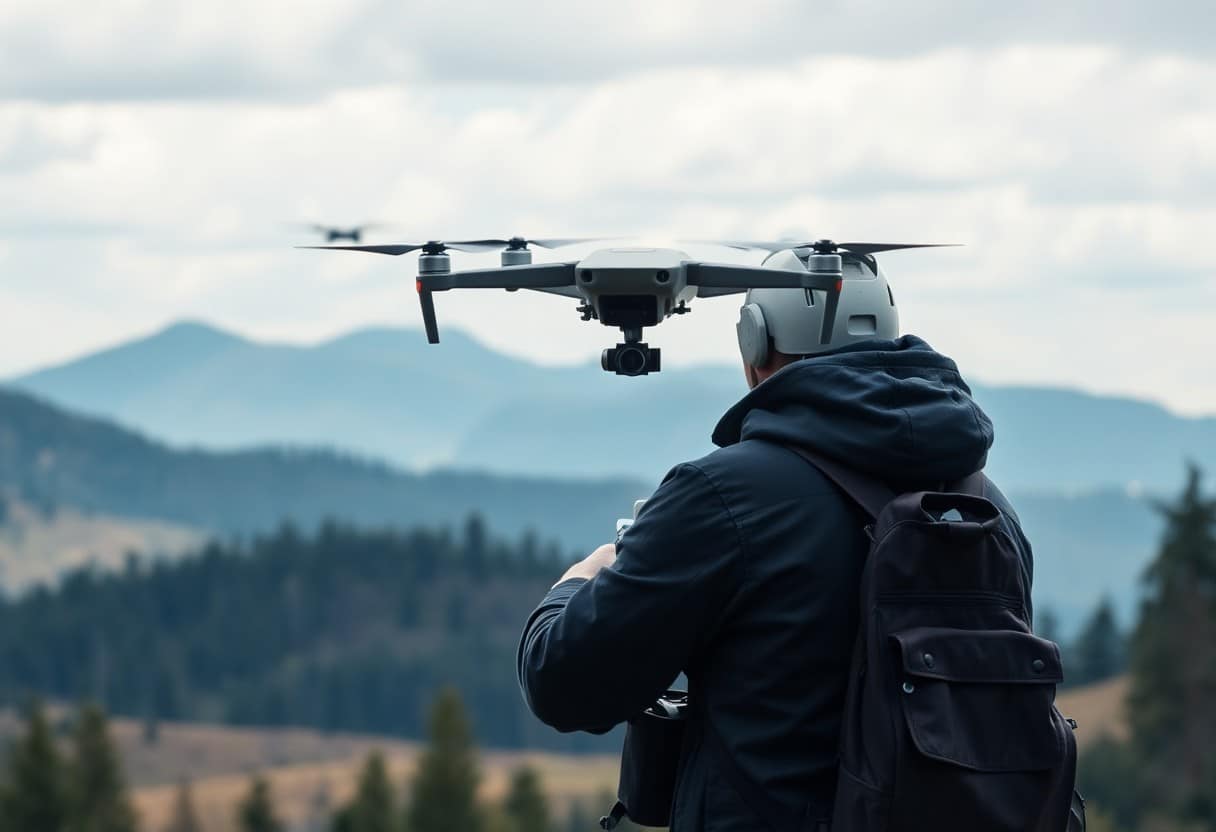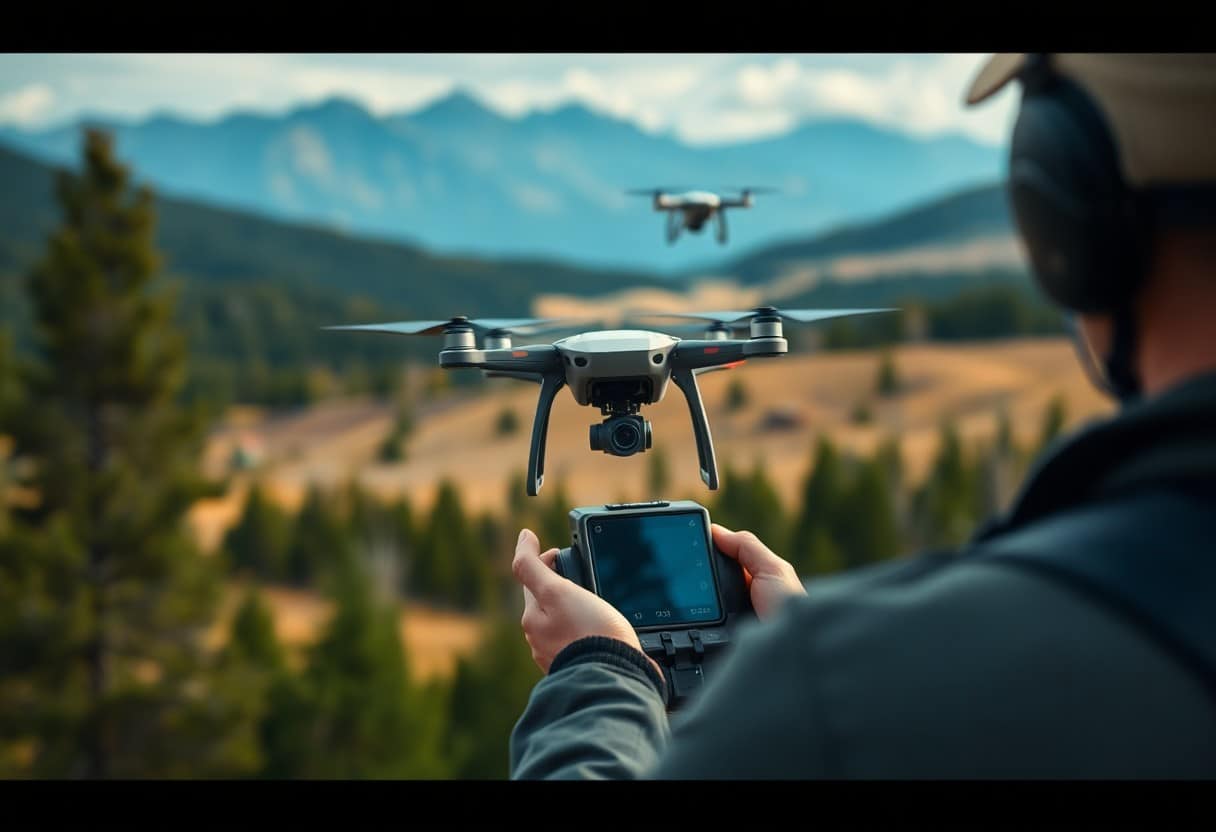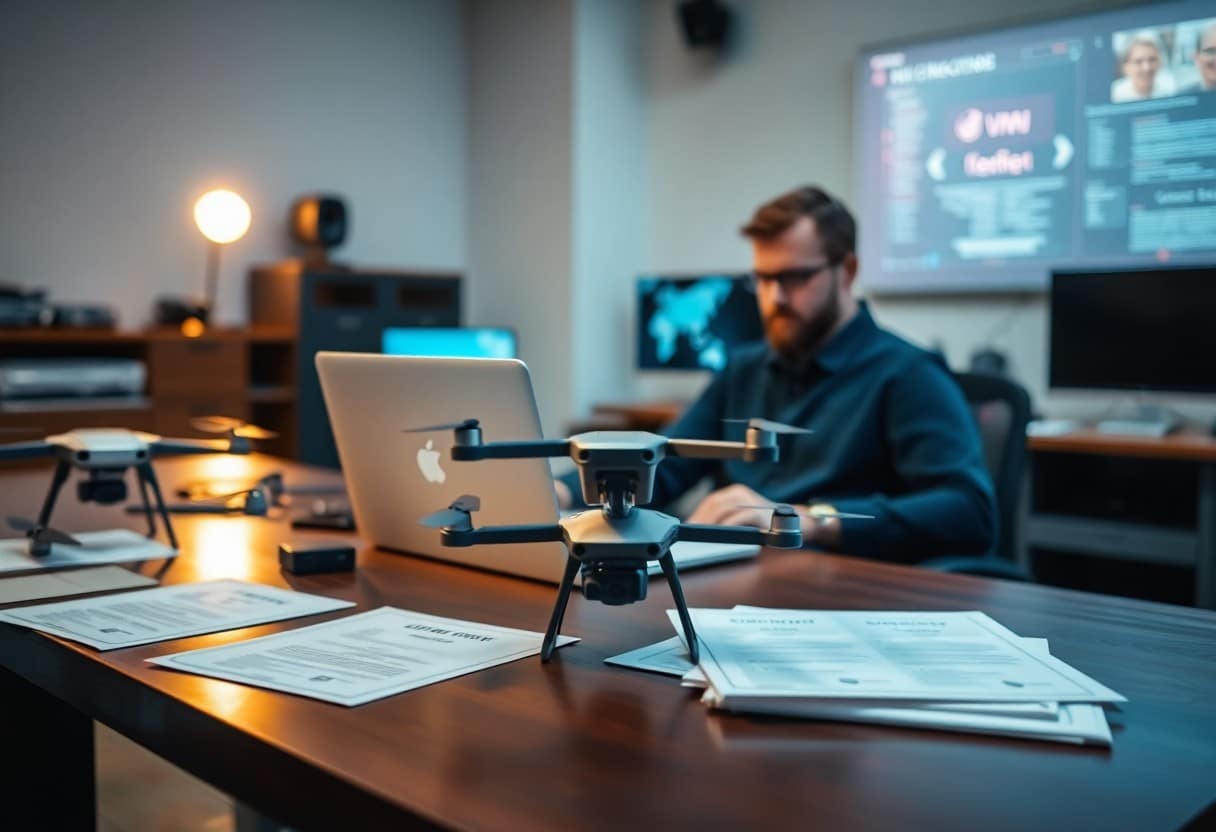Why is it important to keep your eyes open in a drone?
In conducting drone operations, theMaintaining the Visual CordIt is a key factor in ensuring safe and efficient flight. This not only helps you to recognize potential hazards and obstacles in time, but also improves your control and ensures that your drone is on the correct path. In addition, by law, the drone must fly within your line of sight to avoid conflicts with other flying objects. Therefore, understanding the importance of visual cues will help increase your safety and responsibility in drone operations.
Key Points:
- safety: Keep in sight to detect and avoid potential collisions and hazards in a timely manner.
- containment: In-sight operation ensures better control of the drone and reduces the risk of loss of control.
- Laws and Regulations: Aviation regulations in many areas require maintaining a line of sight while operating a drone to comply with the law.
- judgment: Maintains the ability to more accurately judge distance, altitude and environmental changes in the field of vision.
- Communications: In-line-of-sight facilitates effective communication between the operator and those around him, ensuring safe collaboration.
- trust: In-sight operations increase public trust in drone operations and promote licensing and support.
- Technical Limitations: Drone technology may have limitations, and in-vision operation helps to balance these shortcomings.

Understanding the visual field
The field of view is the space that you can directly observe and control during drone operations. Maintaining a clear field of view will not only help you manage your drone's flight effectively, but also ensure safety during flight. Understanding the concept of line of sight is critical to your role as an operator, as it determines the extent of your control and potential risks during flight.
Definition and Importance
Line of sight is defined as the ability to observe the position and movement of the drone directly with your naked eye while operating the drone. This is very important because if the drone is out of your field of view, it could result in thego out of controlmaybeaccidental collisionThere is an increased risk that you may not be able to see the roadway. Therefore, maintaining a line of sight is not only a legal requirement, but also protects your safety and the safety of others.
Regulatory Framework
In many jurisdictions, drone operations are severely restricted by laws and regulations that often require operators to control the drone within sight. These regulations are designed to reduce the risk of accidents and protect air traffic safety.
Specifically, drone regulations in various countries emphasize the importance of maintaining visual range. For example, in the United States, the Federal Aviation Administration (FAA) requires drone operators to operate within visual range. This not only helps you stay on top of your drone's status, but also allows you to react in time to avoid potentially dangerous situations. Violations of these regulations can result in fines and even limit your eligibility to operate, so it's not just the law that requires you to comply, it's your responsibility.
Safety Implications of Visual Direct Vision
During drone operations, maintainVisualizationIt's not just about legal compliance, it's about operational safety. By maintainingVisible DistanceThe most important thing is that you are able to respond quickly to emergencies, avoid potential dangers, and protect yourself and others.
Avoiding collisions
During flight, keep theVisualizationAllows you to better track dynamic objects in your environment, thus effectively reducing the number ofRisk of collision. This is especially important in cities or crowded areas where obstacles and other flying machines are often in your field of vision.
Situational Awareness
Situational awareness is an important component of drone operations. The use ofVisualizationThis approach helps you to assess your environment in real time and to understand the dynamics and risks around you. This increased awareness will help you make more informed decisions while flying.
Being situationally aware means you need toStay alert at all times.Observe any potential threats. When you keep your vision straight, being able to quickly recognize changes in your surroundings, such as moving pedestrians, other drones, or environmental factors, will help you toAccident Preventionand improve the safety of your flight. By increasing your situational awareness, you will be able to manage risk more effectively and improve overall operational efficiency.

Technical Considerations
During drone operations, maintainvisible rangeIt is very important. To better understand this point, you may refer toWhat basic drone controls should every new pilot be familiar with?The use of UAVs in different environments is not only a matter of operational safety. This not only relates to operational safety, but also covers the technical limitations of using a drone in different environments. Therefore, mastering these considerations can help you improve the efficiency and safety of your drone's operation.
The Limits of Remote Sensing
During remote sensing operations, the drone'sSensor RangeIts effective operating range is often limited. This means that in certain environments, such as crowded cities or mountainous terrain, you may have difficulty maintaining goodvisible rangeThe program will require additional programs and strategies to meet these challenges.
Communication Challenges
Drone Operations in theCommunication ChallengesMainly from unsignaled areas or multi-path reflections, which may affect your ability to maneuver and
Real-time feedback. Ensuring a stable communication link is essential for safe operation in different environments, otherwise there is a risk of delayed data transfer and unstable control.
Good communication is key in drone operations. If the signal between your drone and the controller is poor, it could result in ago out of controlIf you are unable to adjust your course, it could have a serious impact on your entire operation. When operating in challenging environments, it is important to carefully plan your communication strategy to ensure that you maintain a stable connection so that you can react quickly to unexpected situations and keep your drone and its surroundings safe.

Operational Best Practices
In drone operations.Maintain visual contactis one of the key tasks. Best practices you need to familiarize yourself with include regularly inspecting the environment, maintaining good communication, and following company operating procedures. Getting into the habit of watching for drone flight and obstacles around you at all times will ensure safety and efficiency.
Training and Certification
In order to ensure the safety of drone operations, you must receive the relevantTraining and CertificationThis includes not only technical skills but also knowledge of how to respond to emergencies and comply with the law. This involves not only technical mastery, but also an understanding of how to respond to emergencies and comply with laws and regulations. Regularly attending refresher courses can help you update your knowledge and skills to minimize operational risks.
Implementation Strategy
effectiveImplementation StrategyEnsures you retain visual contact when operating the drone. Establish a reliable code of practice and ensure that it is followed by all operators. In addition, have the necessary equipment in place to enhance surveillance, such as using the drone's visual assist system.
In addition to this, you will need to ensure that all operators understand all the possibilities of the current operating area and region.Obstacles and Risk FactorsThe following are some examples of the types of operations that can be performed on a regular basis. Regular on-site inspections and pre- and post-flight reviews allow for more effective management and improvement of operational processes. At the same time, the use of appropriateTechnical ToolsFor example, ground control stations or visual tracking devices can help you maintain close contact with the drone and improve the safety and efficiency of your operations.
Case Studies
Through the case studies, we can clearly realize thatThe Need to Maintain Visual LinesThe following are a few specific examples. Below are a few specific examples:
- Case 1: At a construction site, a drone is in the500 metersThe mission was successfully accomplished by running within the distance of the
- Case 2: An operator was300 metersLoss of visual contact outside of the drone resulted in a loss of control of the drone, causing theLoss over $10,000The
- Case 3: An event was filmed using a drone, and the operator kept the800 metersThe visual lines within the screen are successfully presented.
Learn more aboutHow to prepare for the drone authorization process?The
Successful VLOS operation
During a successful VLOS operation, the operator has a clear view of the drone, which not only ensures that thesuretyIt also improves the quality of theReliability of Assignment. With good visual contact, you can observe the drone status in time and react quickly.
VLOS Failures and Lessons Learned
The VLOS failures have brought to light a number of potential risks. For example, some operators neglected theEnvironmental FactorsThis is a good example of how to maintain clear visual contact, which can cause the drone to go out of control. This shows you that maintaining clear visual contact is the key to safe navigation.
The VLOS failure event is a good example of how in drone operations theImportance of visual contactThe operator may not be able to adjust the drone quickly enough to avoid damage to the drone. For example, in some cases, due to weather changes or sudden obstacles, the operator was unable to make quick adjustments, resulting in damage to the drone or even accidents. These lessons emphasize the need to carefully consider all factors before operation and to always maintainvigilance. It is highly recommended that you always maintain visual contact with the drone when performing operations to avoid repeating the same mistake.
The Future of Drone Operations
With the rapid development of drone technology, the future of drone operations is full of potential and challenges. You will see more and more application scenarios, from logistics and distribution to agricultural monitoring, the future of drone operations will require flexible technology solutions. In this period of transition, it's important to understandChange Your Lens - 8 Steps to Cinema Drone PhotographyIt is of paramount importance.
Technological Advancement
Advances in technology are reshaping drone operations. You'll experience more efficient navigation systems and smarter automation, making drone operations safer and more reliable.
Evolving regulations
Regulations for drone operations are constantly evolving and you need to stay on top of these changes to ensure your operations are legal and safe.
TheseEvolving regulationsNot only will it affect the way you use your drone, but it may also affect business opportunities. Government agencies and regulatory organizations are actively looking at ways to regulate the use of drones to enhancepublic securityIt is important to understand the details of these regulations. As drones become more popular, you may encounter more stringent requirements to ensure the safety and compliance of drone operations. Staying up-to-date with the latest regulations will keep you on top of the industry. Especially in an ever-changing environment, utilizing drone best practices ensures that you are complying with the latest regulations, thus increasing your confidence in your maneuvering and scope of operations.
Why is maintaining visual contact so important in drone operations?
Maintaining visual contact is essential in drone operations because it not only enhances your control of the flight path, but also helps you to recognize potential obstacles or hazards in a timely manner. Failure to observe the drone's movements effectively can lead to loss of control or accidents that can affect flight safety. Maintaining visual contact also helps to comply with local laws and ensure that your operations are conducted legally. As an operator, you should always prioritize line-of-sight contact to ensure safe and stable operations.
Frequently Asked Questions
Q: Why is it so important to maintain visual contact during drone operations?
A: Maintaining visual contact is crucial in drone operations because it helps the operator monitor the position and status of the drone at all times to ensure safe flight and avoid collisions and other accidents.
Q: How do I maintain visual contact with the drone?
A: Maintaining visual contact with the drone can be accomplished by selecting appropriate flight sites, using high quality surveillance equipment, and following relevant laws and regulations.
Q: What should I do if I can't maintain eye contact?
A: If visual contact cannot be maintained during flight, stop the flight immediately and take the necessary action according to local laws and regulations, such as changing modes of operation or landing safely.
Q: What are the risks of losing visual contact?
A: Loss of visual contact may increase the risk of collision with other objects or obstacles, and may cause the drone to go out of control or fly into prohibited airspace, thereby jeopardizing public safety.
Q: Is there a legal requirement to maintain visual contact?
A: Many countries and regions have legal requirements for drone operation, which stipulate that the drone must be maneuvered at a visible distance to ensure safety and reduce risk.
Q: How does visual contact affect drone control?
A: Visual contact improves the operator's reaction speed and decision-making ability, which helps to quickly determine the operating status of the drone and thus effectively respond to unexpected situations.
Q: What techniques are available to help improve the maintenance of visual contact?
A: The use of high-resolution cameras, automated navigation systems, and ground control stations in conjunction can go some way toward helping the operator better maintain visual contact, but rules still need to be followed to ensure safe flight.




